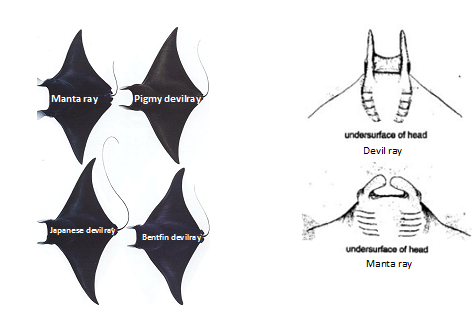Devil Ray Interest Sighting When Dive in Raja Ampat
Diving Raja Ampat is known for its rich marine biodiversity, thanks to its strategic location in the heart of the Coral Triangle and its unique position between the Indian and the Pacific Ocean. Surveys by Conservation International suggest that the area has the greatest diversity of marine life known on the planet and that 75% of the world’s species live here. This may also be attributed to the massive coral colonies as well as warm ocean temperatures throughout the year.
Over 550 species of coral, 1,427 species of fish and more than 700 different types of mollusks have made this the major epicenter for marine life. However, one of the greatest attractions amongst divers who visit the area is Manta Rays. Manta Rays can be found all over the world, but those that are sighted in Raja Ampat are unique; while Manta Rays from other parts of the world are dark on the upper side and light on their lower side, those found in Raja Ampat are dark on both sides. Therefore they have been given the name Black Mantas.
Black Mantas are endemic to the region and can be sighted throughout the year. Tourists will truly benefit when visiting the area between October and April when large populations of Black Mantas – attracted by a high concentration of nutrients and plankton – migrate to the area. It is not uncommon to see Black Mantas making tremendous leaps above the surface of the water during this time of year.
If you really want to see a grand spectacle, then head down to Manta Sandy diving site. This is considered the cleaning station for black Manta Rays, which flock by the hundreds to the area for a chance to get their wings cleaned by small wrasse that feeds on parasites.
Devil Rays
Apart from Black Mantas, When you diving Raja Ampat is also known for popular sightings of the unique Devil Rays. You are more likely to spot them during high season between October and April, and mostly between Friween and Gam Island. They are social creatures and are usually spotted in groups of 6.

Identifying a Devil Ray is easy if you know what features to look out for. Some unique features include:
- Distinctive large body disc
- Long slender tail-like-whip that lacks a spine
- White lower side
- Dark brown or bluish black upper side
- Large pectoral fins that extend past the head
Devil Rays are common in tropical waters and are known to travel in schools. They feed primarily feed on plankton and therefore often found in stretches of ocean that are rich in plankton such as Raja Ampat. Raja Ampat gives you the opportunity to get up close and personal with these unique marine dwellers. Stay tuned to our blog to get more new information about diving in Raja Ampat.


4 Comments
Through scientific research and long-term commitments in the areas we work, we strive to create a better understanding of manta rays and the human communities that interact with them.
Through scientific research and long-term commitments in the areas we work, we strive to create a better understanding of manta rays and the human communities that interact with them.
This time of the year is not only for mantas, we have a very high encounter of Devil Rays in the channel between Gam island and Friween, and more spec f8 ifically in our House Reef!
Raja Ampat is one of the places where you can see manta rays, most of the mantas have white belly, but in Raja Ampat you also can find Black Mantas, completely black top and bottom, this type of Black Mantas are endemic of this region!